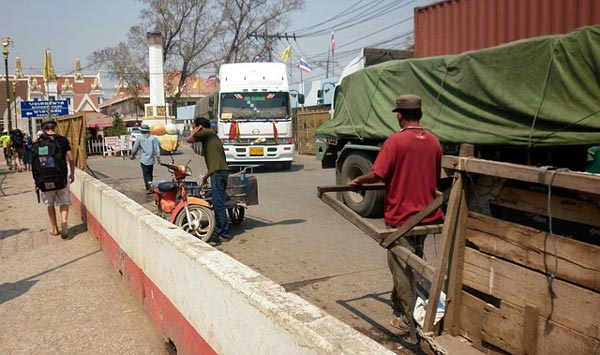After receiving several inquiries from readers of my other related posts, who were confused about the difference between a visa run and a border run, I decided to clarify exactly what these terms involve and the distinctions between the two.
To begin, let's understand why you might need to do a visa or border run in the first place.
When you enter Thailand, you will receive an exemption stamp, allowing you to stay for either 30 days or 15 days, depending on your country of origin.
Once this duration is over, you must leave the country.
To extend your stay, you have the option of visiting an immigration office and paying a fee of 1,900 Baht, but this can only be done once.
Another way to extend your stay is to exit the country and return.
Moreover, those who possess a visa have a specific period allowed for their stay in the country, usually 60 or 90 days, depending on the type of visa.
Upon reaching the end of this period, they must either extend their visa inside Thailand or leave the country. If they leave, they can either return to reactivate another period of validity on their existing visa or obtain a new visa from a consulate or embassy in another country.
Let's delve into this topic further to gain a deeper understanding.

The border separating Thailand and Cambodia, Aranyaprathet to Poipet.
The Difference Between a Visa Run & Border Run
The terms “visa run” and “border run” can be used interchangeably, though there are nuances pertaining to different circumstances.
Both require you to go across the border and back, so essentially they are one of the same thing. However, depending on your situation, they may mean slightly different things.
For the sake of this post I'll provide examples to explain how they can differ slightly in meaning, but by the end of the post you'll see why they are really one and the same.
The Visa Run
If you do not have a visa and are seeking to obtain one, you will need to visit a consulate or embassy outside of Thailand.
This will likely require you to stay for one or two nights in your destination, giving you enough time to visit the consulate or embassy, apply for, and collect the visa.
Arguably, this is the primary difference between these two terms.
In this scenario, the term “visa run” would be more applicable because you are crossing the border to obtain a visa.
However, the term “visa run” can still be applied to those who already have a visa, as we'll discuss below, since they are seeking to get a new stamp in their visa by running to the border.
The Border Run
When people use the term “border run,” it generally refers to the fact that they already have a visa or are seeking to re-enter the country on an exemption stamp. In this case, they need to go over the border and return on the same day.
So, the term “border run” essentially means literally going over the border and coming back (running to the border and back = border run).
Several companies offer this service, and a typical border run involves obtaining a ticket from a border run company and boarding a minivan early in the morning. The minivan will then take you to the nearest border, usually involving a 3-4 hour trip there and back.
Upon reaching the destination country's side of the border, you turn around and return directly to Thailand, obtaining a re-entry stamp in the process.
Land Border Runs
If you do not have a proper visa and were previously on an exemption stamp, which would have given you 30 days on arrival at the airport (or 15 days, depending on your country of origin), re-entering Thailand via land will grant you a new stamp with a validity of 30 days.
It used to be the case that leaving Thailand and returning would only get you a 15-day stay, but this rule has since changed for most nationalities.
Additionally, immigration authorities keep track of the number of “in-out” stamps in your passport. If you abuse the system by repeatedly entering and leaving the country without obtaining a proper visa, you may expect to be stopped by immigration officials, questioned on this matter, and possibly refused a new stamp.
If you aren't sure whether your country of origin will permit you a 15 or 30-day stay in Thailand, you can check here on Wikipedia.
A few lucky countries – Argentina, Brazil, Chile, South Korea and Peru – are allowed 90 days within any 6 months.
Airport Border Runs
Flying in and out of Thailand can still be considered a border run or a visa run because you are crossing a border, turning around, and coming back in. However, the rules will be slightly different for those who do not have a proper visa.
If you fly out of Thailand and return on the same day, you can receive another 30-day stamp on arrival. Nevertheless, if you frequently engage in airport border/visa runs, expect to be questioned by immigration at some point.
Immigration officials will inquire about your intentions and ask why you need to keep leaving and returning to Thailand.
If you have a girlfriend, wife, or family in Thailand or if you are working there, they will want to know why you haven't obtained the appropriate visa for your situation.
Even if you are simply a tourist who enjoys visiting repeatedly, they will ask why you have not acquired a tourist visa for this purpose.
Indeed, I advise obtaining a tourist visa rather than doing back-to-back border/visa runs – it will save you any hassle with immigration. A tourist visa is relatively cheap and easy to obtain. See here.
Getting Your Visa Stamped (at the border)
For those who do have a proper visa, such as a Multiple Entry Tourist Visa or a Multiple Entry Non-Immigrant O Visa, when you cross the border and return, you will receive a stamp that activates a new validity period for your existing visa.
If you have a Multiple Entry Tourist Visa, you will be granted another 60 days of stay. On the other hand, if you have a Multiple Entry Non-Immigrant O Visa, you will be given an additional 90 days of stay.
It's worth noting that these visas can be extended at immigration for a cost of 1,900 Baht. So, if you are unable to do a border run, you can still extend your visa for a certain period by visiting immigration with the required documentation and fee.
If you possess a Non-Immigrant O Visa, you will be allowed to extend once during the yearly validity period, for 60 days. For those with a Multiple Entry Tourist Visa, you can extend once within the visa validity period, for 30 days.
For those who are new to this process, I hope this post provides a clear insight into what a visa/border run is, why it is necessary, and the differences between the two terms.
If your visa is about to expire and you need to leave the country to activate another period of validity, or you simply want to enter and exit to receive another 15 days in Thailand, or even if you want to visit the consulate or embassy of another country to obtain a visa, you can find my recommended visa/border run itinerary at the link below.
Getting a Visa to Cross the Border
Depending on your nationality, you may need a visa to cross over the border into the country where you are doing your border/visa run. For example, the large majority of nationalities will require a visa to enter Laos.
In Laos, this visa can be obtained and paid for at the border. You can pay in US Dollars or Baht, with US Dollars usually being the cheaper option.
However, you also have the option to get your visa in advance, which can be advantageous and more convenient. By doing so, you won't need to fill in the visa application form upon arrival or fiddle with money at the border.
You can use the widget below to determine whether or not you need a visa for your destination country.
Visa Document Checker
If you are considering doing a visa run, then check out my recommendation for the fastest, most comfortable, most affordable visa run option.
In this post, I break down the entire visa run step-by-step, and even recommend great but cheap accommodation for those who need to stay overnight to in order to visit the Thai embassy.
The Fastest & Most Comfortable Visa Run Under 3,000 Baht [In 10 Easy Steps]
Last Updated on



john rich says
regarding the visa-on-arrival that tourists get at the BKK airport. you mentioned this type of visa can be extented only once. can you define "once"??? for example, last January (2023) i extended my visa on arrival for an additional 30 days. after my 60 days were complete, i left the country and continued traveling around the world. i came back to Thailand on Sept 25 and got another visa-on-arrival for 30 days. i would like to extend my visa-on-arrival one more time. can i do this again, or do i need to leave the country????
Sep 10, 2023 at 8:36 pm
TheThailandLife says
Sep 10, 2023 at 11:06 pm
JOHN says
Sep 03, 2023 at 10:01 am
JamesE says
Your plan might work, or it might not. Same day border runs used to be the default but with the crackdown on visa abuses the casual interpretation of the rules is a thing of the past. If, say, you flew to Vietnam for five days and then returned you'd have less of a problem than if you just bounced across the border (or stayed in the transit area of an airport) before returning to Thailand..
Sep 03, 2023 at 10:05 pm
JOHN says
Sep 03, 2023 at 11:54 pm
lane sands says
Aug 21, 2023 at 7:14 am
TheThailandLife says
Aug 21, 2023 at 4:13 pm
Galen Hieb says
Aug 01, 2023 at 5:52 am
TheThailandLife says
Aug 01, 2023 at 5:33 pm
Ronald says
I was allowed back through customs (as I still had 30 days left on my visa) but discovered later I did not receive a new "entry" stamp.
Now those full 90 days are coming than end. Unfortunately my wife is still not fully recovered and I would like to know how, if even possible, I could ask for an additional 30 days and also, what will happen when immigrations sees I have nor an entry stamp nor the usual departure card which was kept by immigrations when we tried to leave. That was not returned nor was a new one issued.
During this sequence of events I was too concentrated on taking care of my wife to think about everything and assumed immigrations was doing their job correctly.
Thanks in advance for any help.
Feb 27, 2022 at 8:12 am
Mike Baker says
Feb 28, 2022 at 8:33 am
Richard Edwards says
Nov 19, 2020 at 7:08 pm
John says
Jul 02, 2020 at 12:21 pm
TheThailandLife says
Jul 02, 2020 at 3:15 pm
frank borgmann says
May 27, 2020 at 1:17 pm
Erik de Koning says
Currently with most of the borders around Thailand being closed, it looks like a border run would not be possible.
What should I do?
Mar 23, 2020 at 12:19 pm
TheThailandLife says
Mar 24, 2020 at 5:51 am
Ellee says
Mar 15, 2020 at 1:55 am
TheThailandLife says
Mar 15, 2020 at 3:09 am